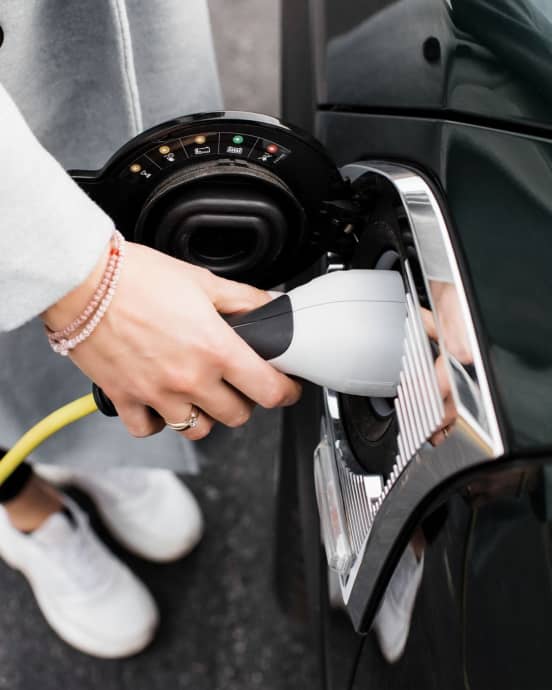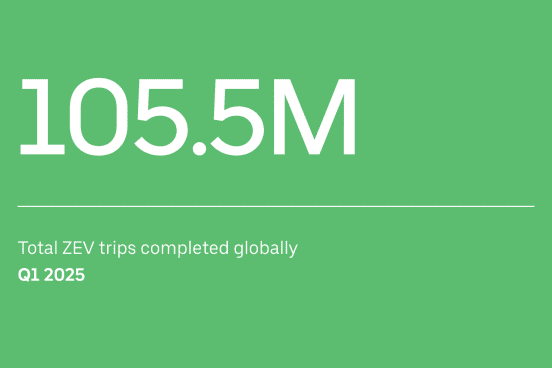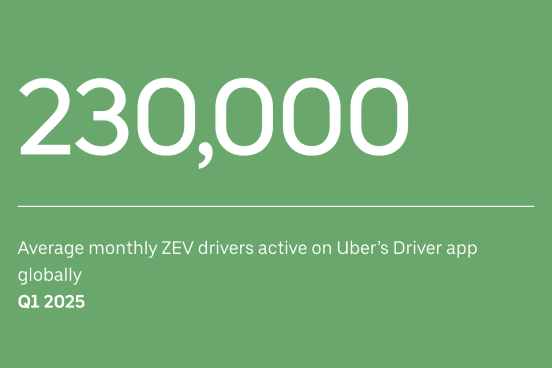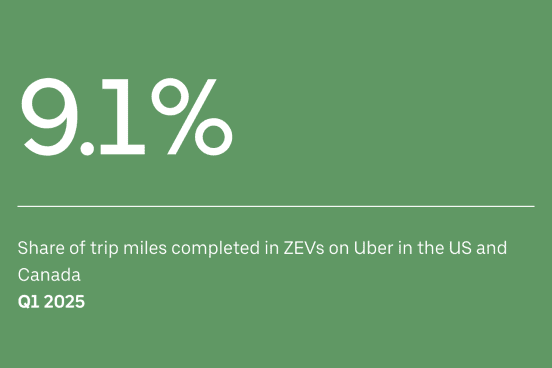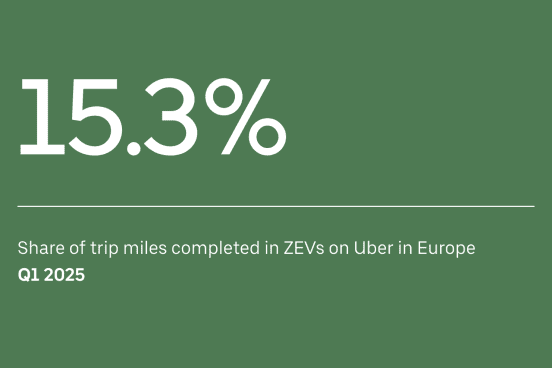Uber’s Electrification Update
"Our ambitious efforts to transition to a zero-emission mobility platform have seen meaningful progress. Today, Uber is the world’s most widely available platform for zero-emission rides, with drivers adopting EVs up to 5 times faster than average motorists in the US, Canada, and Europe."
Rebecca Tinucci, Global Head of Electrification and Sustainability, Uber
Q1 2025 Update: This page includes metrics for trips completed on Uber by internal combustion engine (ICE) vehicles and zero-emission vehicles (ZEVs, such as battery EVs) from the beginning of the first quarter of 2021 to the end of the first quarter of 2025. Note that the scope of this report includes only Uber’s Mobility business (ridesharing).
Tracking our journey to zero emissions
Five years into our ambitious effort to transition to a zero-emission platform, we’ve made meaningful progress. Today, Uber is the world's most widely available platform for zero-emission rides, with drivers adopting EVs (electric vehicles) up to 5 times faster than average motorists in the US, Canada, and Europe.
We’ve invested hundreds of millions of dollars to help interested drivers make the switch to electric through incentives, partnerships, and product enhancements—and it’s paying off. Increasingly, riders are experiencing their first EV on Uber, helping to normalize and accelerate the adoption of electric transport all over the world.
Our data shows that EV progress quickens when government and industry work together to get the economics right. In cities like London, Vancouver, and Amsterdam, where thoughtful policies, industry investment, and strong charging networks align, more than 1 in every 3 miles on Uber are now electric.
Despite this significant progress, major barriers remain to fully achieve our goals. High upfront EV costs, limited charging access, and inconsistent policy support continue to slow adoption. Based on current trends, we cannot meet our remaining mobility and delivery goals for 2025, and our 2030 goals will be out of reach without stronger, coordinated action across government and industry.
As we’ve said from the start: climate is a team sport, and progress depends on collective action. That’s why we’re increasingly prioritizing efforts in cities where public and private investment are aligned.
While many key levers are outside our control, we remain deeply committed to this transition—not just because it’s the right thing to do, but also because it brings direct and strategic business benefits. Thousands of drivers around the world are taking home more money thanks to lower EV operating costs and rider demand for electric vehicles. Riders report higher satisfaction with the EV experience and are increasingly choosing EVs.
And finally, the future is shared, electric, and autonomous—and the coming wave of autonomous (electric) vehicles will create a major tailwind in achieving our sustainability goals.
Our latest update below outlines the progress to date, key insights, and areas of focus for 2025 and beyond.
__
Rebecca Tinucci, Global Head of Electrification and Sustainability, Uber
May 7, 2025
Socios conductores de ZEV
Globally, more than 230,000 ZEV drivers were active on Uber’s app in Q1 2025. That’s over 60% more than the same period a year earlier.
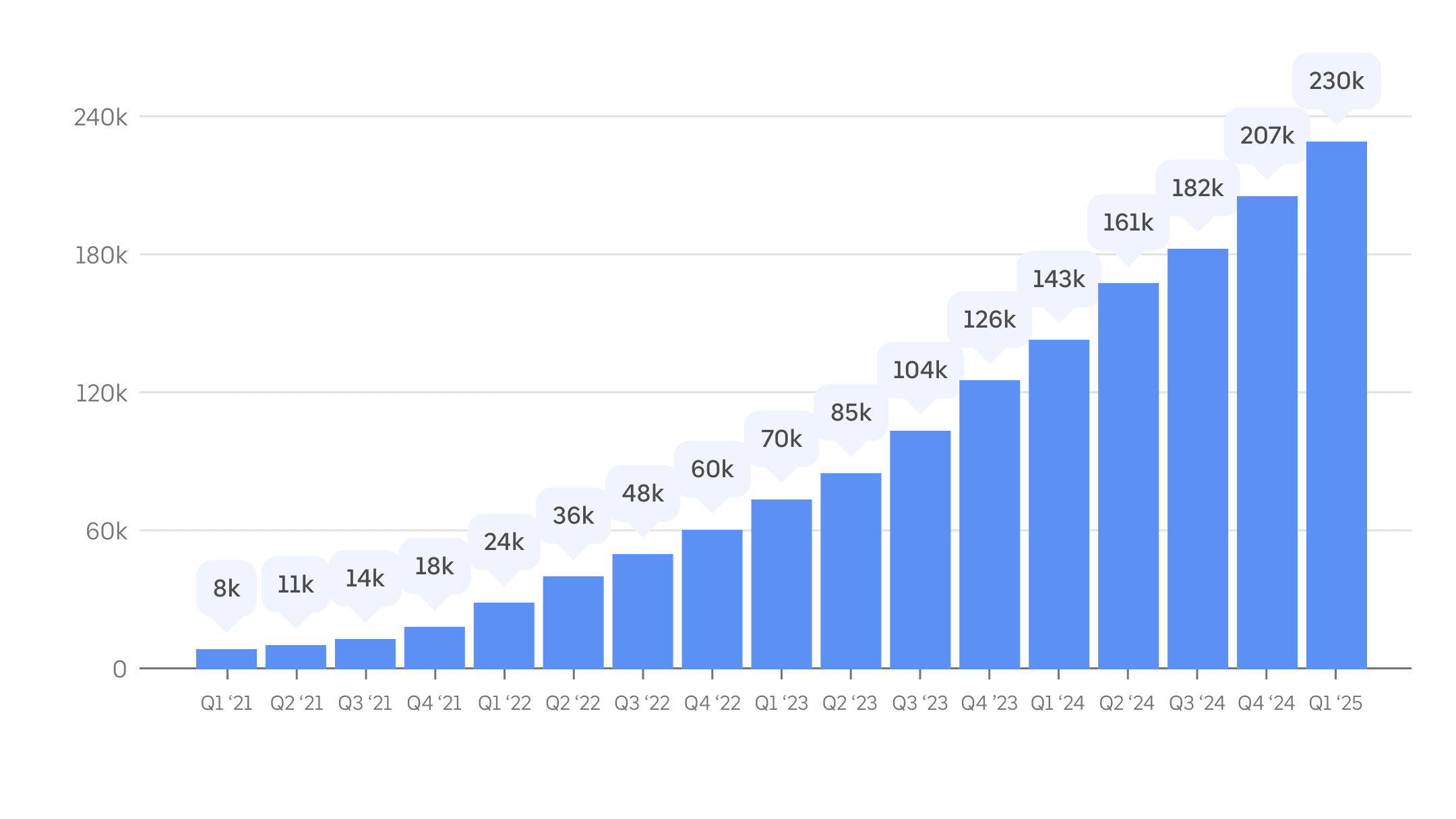
Metric: Average monthly active ZEV drivers on Uber, by quarter, since Q1 2021. Drivers using Uber’s app are counted as active in a given month if they’ve completed at least one trip in that calendar month.
Viajes en ZEV
In Q1 2025, ZEV drivers completed over 105 million tailpipe-emissions-free trips using Uber, globally—over 60% more than the number of ZEV trips completed on Uber during the same period a year earlier. That’s more than 13 ZEV trips on Uber every second, on average.
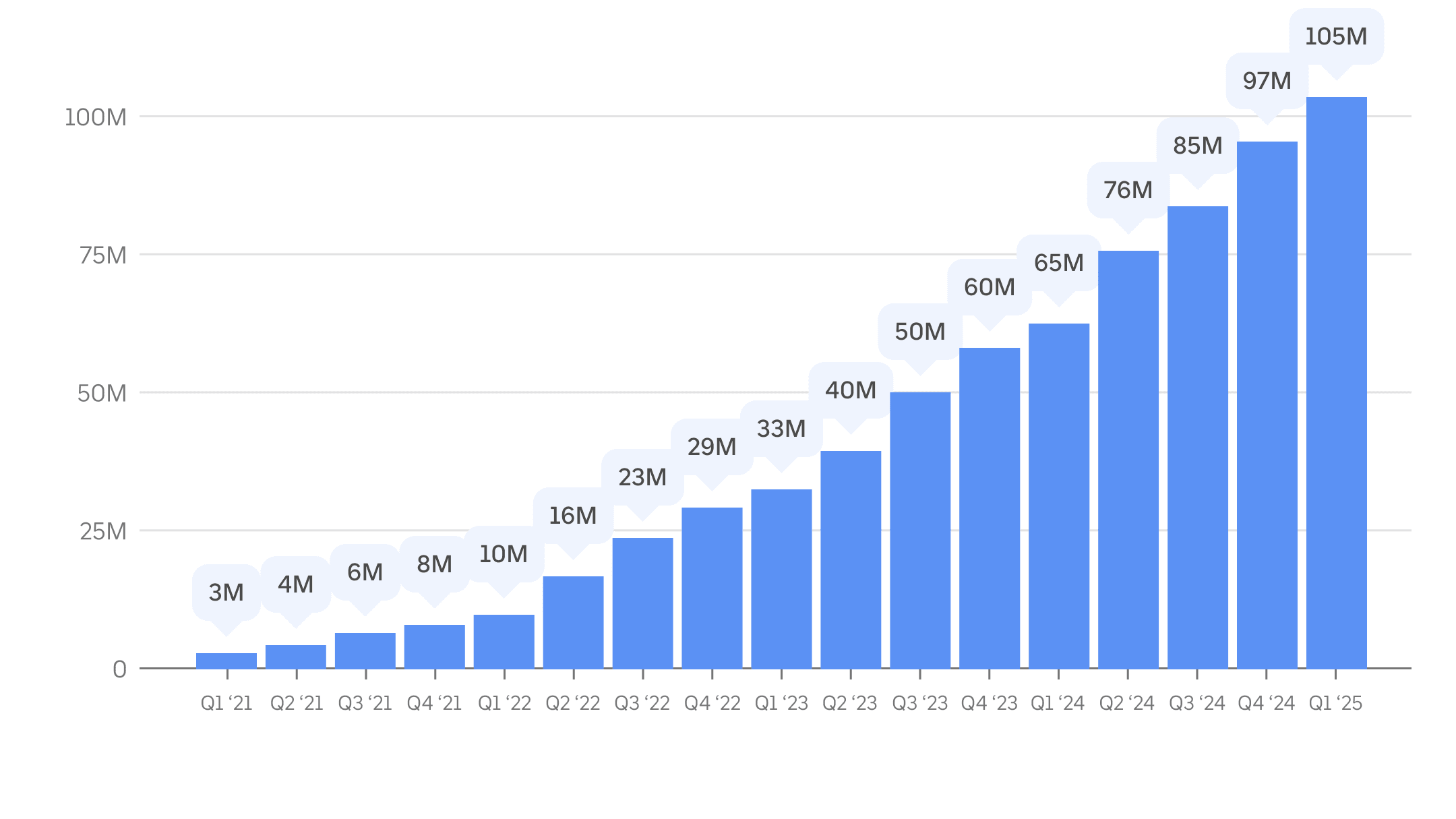
Métrica: Cantidad de viajes organizados en la app de Uber y completados por socios de la App que conducen ZEV, por trimestre desde el primer trimestre de 2021.
Adopción de los ZEV
In Q1 2025, ZEV drivers completed 15.3% of all on-trip miles in Europe and 9.1% of all on-trip miles in Canada and the US—adoption levels many times above drivers in the general public. Figures published in a 2024 BloombergNEF report show that ZEV uptake by Uber drivers in Europe was about 5 times faster than that of typical motorists.
Over the last 4 years, the average annual increase in all-electric on-trip mileage share on Uber in Europe and in the US and Canada was 3.1 and 2.2 percentage points, respectively. The highest and lowest annual increases recorded over that period occurred in the last year: since Q1 2024, ZEV uptake jumped more than 6 percentage points in Europe and just under 1 in the US and Canada.
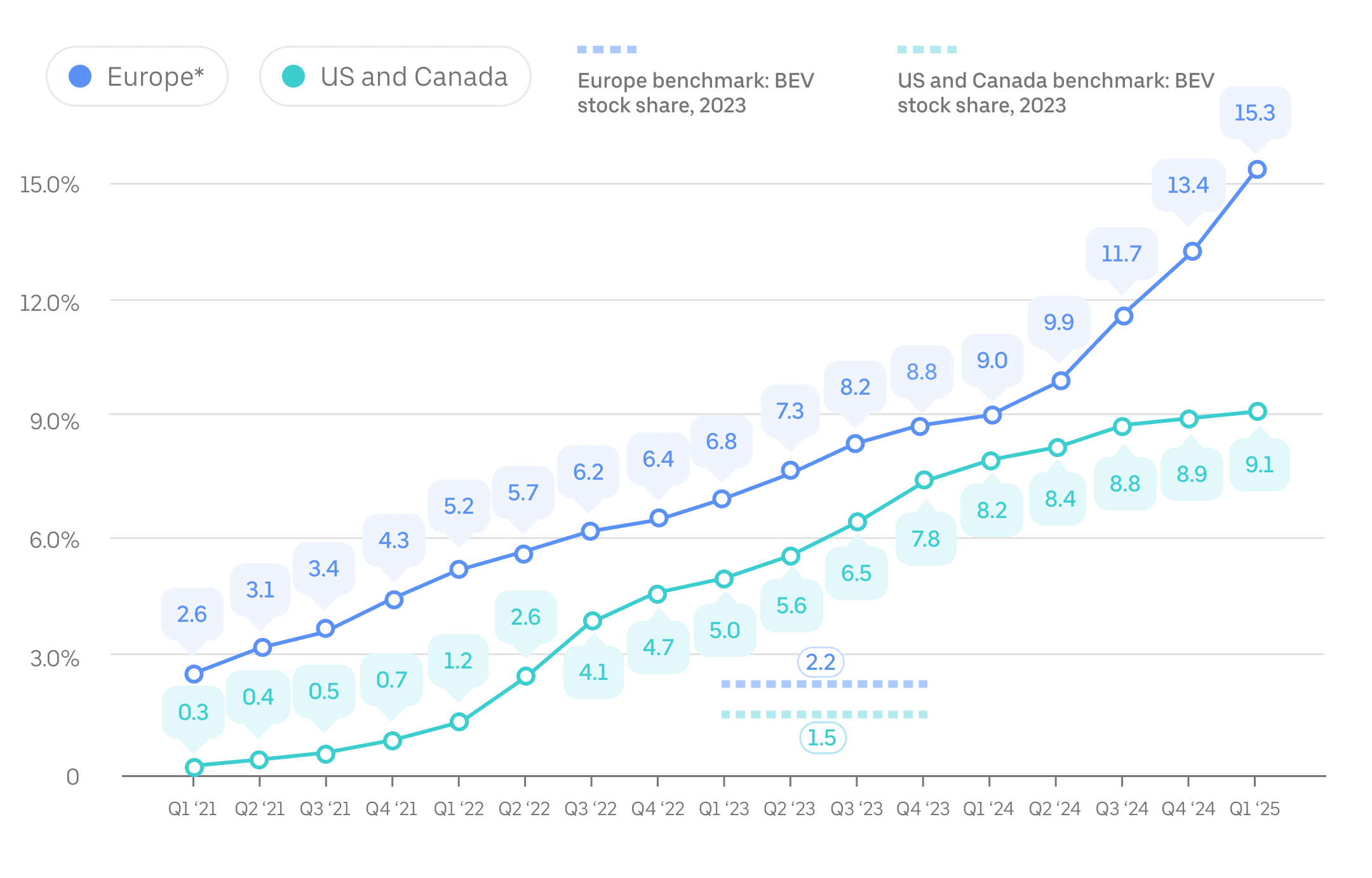
Metric: Share of on-trip miles completed in ZEVs compared with all on-trip miles arranged by the Uber app, by quarter since Q1 2021. Canada, US, and European benchmark data is as of 2023 (the most recently available at the time of this update) and is sourced from the International Energy Agency. “BEV” refers to battery electric vehicles.
Intensidad de las emisiones de carbono por usuario
In 2024, each mile that a passenger traveled on Uber resulted in an average generation of 197 grams of CO₂ in Europe (or 123 grams of CO₂ per kilometer) and 340 grams of CO₂ in the US and Canada (or 212 grams of CO₂ per kilometer). Compared with 2021, this passenger carbon intensity metric fell nearly 14% in Europe and 6% across the US and Canada.
Passenger carbon intensity in Europe, the US, and Canada increased slightly between 2023 and 2024 due to minor decreases in average passenger occupancy and increases in “deadheading” (vehicle mileage incurred before and on the way to picking up passengers).
Métrica: Intensidad de carbono de los pasajeros, o los gramos estimados de CO₂ por pasajero y milla recorrida, es una métrica anual de clima y eficiencia que usa Uber y, cada vez más, gobiernos y empresas de todo el mundo. En el caso de los viajes compartidos o de cualquier servicio de movilidad a pedido, las emisiones producidas por las millas muertas, es decir, las millas recorridas en vehículos sin un pasajero, se tienen en cuenta en el cálculo.
Para obtener más detalles sobre cómo calculamos la intensidad de las emisiones de carbono de los usuarios, visita nuestro documento sobre la metodología. Ten en cuenta que el ahorro de combustible promedio significativamente más bajo para los vehículos que usan la app de Uber en Europa en comparación con EE. UU. y Canadá explica la mayor parte de la diferencia en la intensidad de carbono en estas 2 geografías. Si bien la composición de los vehículos que los socios de la App usan en la app de Uber en Europa es más eficiente, con una mayor proporción de vehículos de bajo consumo e híbridos, las normas más estrictas de informes de ahorro de combustible en EE. UU. también contribuyen a esta discrepancia. Además, no tenemos acceso a datos de entrada suficientes para calcular la intensidad de las emisiones de carbono de los usuarios para los viajes completados en los mercados europeos antes de 2021.
Información y análisis profundos
EVs for everyone: balanced adoption of a maturing technology
Hacer de la sostenibilidad la mejor opción (2024)
How to help spark electric mobility across Europe
Reducción de emisiones con rutas sostenibles (2023)
Por qué viajar con la app Uber es tan diferente a usar vehículos privados (2021)
Medición de la movilidad en función de la intensidad de la emisión de carbono (2019)
Preguntas frecuentes
- What is in Uber’s Electrification Update?
Our Electrification Update provides interested stakeholders with performance-based metrics on carbon-related emissions and electrification for passenger vehicle trips enabled by the Uber app.
- Why are you publishing this update?
Down Small This update, based on real-world use of our mobility platform, helps provide greater transparency of our electrification impact and helps us improve our efforts to support efficiency on our platform.
- What are the key measurements you use in the Electrification Update?
Down Small Las métricas incluyen lo siguiente:
- Uso de vehículos de cero emisiones (Zero-Emission Vehicle, ZEV) por parte de los socios de la app de Uber (porcentaje de millas o kilómetros recorridos en un ZEV), lo cual mide nuestro progreso hacia nuestra meta de una movilidad del 100% con cero emisiones por parte de Uber a nivel mundial para el año 2040
- Intensidad de las emisiones de carbono por usuario, que mide las emisiones resultantes de cada milla recorrida por usuario
- How will this update improve emissions reduction and electrification uptake for rides on Uber?
Down Small We have bold ambitions to reduce the passenger carbon intensity of trips and increase the use of zero-emission vehicles on Uber. Measurement and transparency of the progress are important steps along our journey.
- ¿Los usuarios realizan viajes con la app de Uber en lugar de usar opciones con bajas emisiones de carbono, como el transporte público?
Down Small Los viajes con la app de Uber son una de las muchas opciones de transporte disponibles para las personas que buscan un viaje. La elección del tipo de viaje depende mucho de las diversas condiciones del mercado local. Nuestro análisis de los datos de la Encuesta Nacional de Viajes Familiares de EE. UU. muestra que una mayor utilización por hogar de los modos de transporte más sostenibles (transporte público, caminar y bicicleta) se correlaciona con una mayor utilización de viajes compartidos y otras soluciones a pedido.
- ¿Medirán los mismos datos para otros países o regiones del mundo?
Down Small Many of the above metrics now cover all passenger trips completed with the Uber app globally. We’re aligned to regular reporting on carbon emissions and other impact areas resulting from trips on Uber.
- With what frequency do you expect to provide Uber’s Electrification Update?
Down Small We update metrics at least annually and may update some metrics more frequently. We’ll release emissions metrics (like passenger carbon intensity) annually, aggregated by calendar year.
- ¿Qué significa un “vehículo de cero emisiones”?
Down Small Usamos el término “vehículo de cero emisiones” (zero-emission vehicle, ZEV) al igual que la Junta de Recursos del Aire de California (CARB) y la Federación Europea de Transporte y Medio Ambiente (T&E) para referirnos a los vehículos que no producen emisiones directas de CO2 u otros contaminantes atmosféricos críticos (como el NOx, partículas en suspensión, CO2 y SOx) procedentes de la fuente de energía incorporada. Las variaciones regionales deben considerarse a discreción del lector.
Actualmente, los socios que usan la app de Uber usan 2 tipos de ZEV: vehículos eléctricos a batería (battery electric vehicles, BEV) y, muy de vez en cuando, vehículos con celda de combustible de hidrógeno (hydrogen-powered fuel cell electric vehicles, FCEV).
Por supuesto, el “cero” en los ZEV se refiere a la ausencia de emisiones del famoso “tubo de escape” y no necesariamente a todas las emisiones que se pueden registrar desde la producción hasta la eliminación del vehículo y su fuente de energía. Sin embargo, todos análisis del ciclo de vida útil realizados por expertos independientes demuestran que “las emisiones a lo largo de la vida útil de los BEV de tamaño medio matriculados hoy en día son inferiores a las de los vehículos de gasolina comparables en un 66% y 69% en Europa, en un 60% y 68% en los Estados Unidos, en un 37% y 45% en China y en un 19% y 34% en la India, respectivamente”.
- Will you measure impact for your Delivery business?
Down Small Our Electrification Update currently covers electrification and emissions metrics only for our Mobility business (ridesharing). We aim to include our progress on delivery emissions and electrification in future.
On packaging, Uber continues to invest in helping merchants transition to sustainable options. However, as with electrification, progress depends on collective action. We’re prioritizing efforts in cities where public and private investments are aligned. For example, in France over 60% of packaging used on the platform is recyclable, reusable, or compostable, supported by national policy and local incentives.
While progress has been made, based on current trends, we cannot meet all 2025 goals, and our 2030 goals will be out of reach without stronger, coordinated action across government and industry.
While many key levers are outside our control, we remain deeply committed to this transition. To learn more about Uber’s approach to more sustainable packaging with merchants, consult our Uber Eats for Merchants web page.
- ¿Uber divulga las emisiones de Alcance 1, 2 y 3? De ser así, ¿dónde se encontrarían?
Down Small Uber discloses Scope 1, 2, and 3 emissions to CDP. You can find our most recent score in CDP’s public corporate score search. These emissions estimates have received limited assurance from an independent third party.
Esta página junto con el CAsPR y los Informes de factores ambientales, sociales y de gobernanza relacionados (“el informe”) contienen resúmenes prospectivos sobre nuestras expectativas y metas comerciales a futuro, las cuales implican riesgos e incertidumbres. Los resultados reales pueden diferir considerablemente de lo previsto. Para obtener más información, consulta nuestros informes.
Ciertos datos divulgados en este reporte recibieron una garantía limitada de Lloyd's Register Quality Assurance (LRQA). La declaración de verificación de LRQA se puede encontrar aquí.
Puedes encontrar una descripción general del uso de las compensaciones de carbono por parte de Uber aquí.
En este informe, términos como “socios de la App”, “ganancias”, “ZEV” y “empaque ecológico” son generales y siguen el caso de uso general de las palabras de Uber Technologies, Inc. Las variaciones regionales de las palabras se deben considerar a discreción del lector.
Quiénes somos
